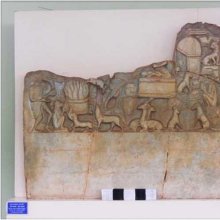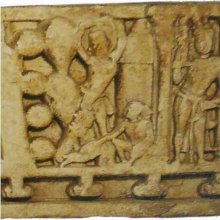Sasa Jataka, Sasa Pandita Jataka: 1 definition
Introduction:
Sasa Jataka means something in Buddhism, Pali. If you want to know the exact meaning, history, etymology or English translation of this term then check out the descriptions on this page. Add your comment or reference to a book if you want to contribute to this summary article.
Images (photo gallery)
In Buddhism
Theravada (major branch of Buddhism)
Source: Pali Kanon: Pali Proper NamesThe Bodhisatta was once born as a Hare. He lived with three friends: a Monkey, a Jackal, and an Otter. The three lived in great friendship, and the Hare was their guide in the good life. One day, the Hare, observing the approach of the full moon, told his friends that the next day would be a fast day and that they must collect food and give it to any beggar who approached them. The animals all went out very early in the morning, one by one; the Otter found some fish buried in the sand; the Jackal a dead lizard, some meat, and a pot of curds; and the Monkey some fruits; and, finding that nobody appeared to claim them, each took them to his own dwelling. The Hare had only kusa grass, which he could not offer to anyone. He therefore decided to give his own body, and, because of this brave decision, Sakkas throne was heated. Disguised as a brahmin, he came to test the Hare. He went first to the other animals in turn and they all offered him what they had. He then approached the Hare, whom he asked for food. The Hare asked him to collect faggots from the wood and make a fire. Then, telling the brahmin that he would give him his own body, without the brahmin having the necessity of killing him, he shook out any animals which might lurk in his fur, and then jumped into the fire as into a lotusbed. By the power of Sakka, the fire remained as cool as snow, and Sakka revealed his identity. Then, so that the Hares nobility might be known to all the world, he took some essence of the Himalaya and painted the form of a hare in the moon, to remain there during this whole kappa. Having done this, he went to the Hare and talked of the Doctrine, and then, making the Hare lie down on his bed of grass, Sakka went back to his heaven.
The story was related in the course of giving thanks to a landowner of Savatthi who had entertained the Buddha and his monks for seven days. Ananda is identified with the Otter, Moggallana with the Jackal, and Sariputta with the Monkey (J.iii.51 6).
The story is included in the Cariyapitaka (i.10) and in the Jatakamala (No. 6). It is also referred to in the Jayaddisa Jataka (J.v.33). This Jataka exemplifies the practice of danaparamita. BuA.50.
Theravāda is a major branch of Buddhism having the the Pali canon (tipitaka) as their canonical literature, which includes the vinaya-pitaka (monastic rules), the sutta-pitaka (Buddhist sermons) and the abhidhamma-pitaka (philosophy and psychology).
See also (Relevant definitions)
Partial matches: Jataka, Pandita, Shasha.
Full-text: Candima.
Relevant text
Search found 1 books and stories containing Sasa Jataka, Sasa pandita jataka; (plurals include: Sasa Jatakas, Sasa pandita jatakas). You can also click to the full overview containing English textual excerpts. Below are direct links for the most relevant articles:
Reviews < [January-February, 1930]

